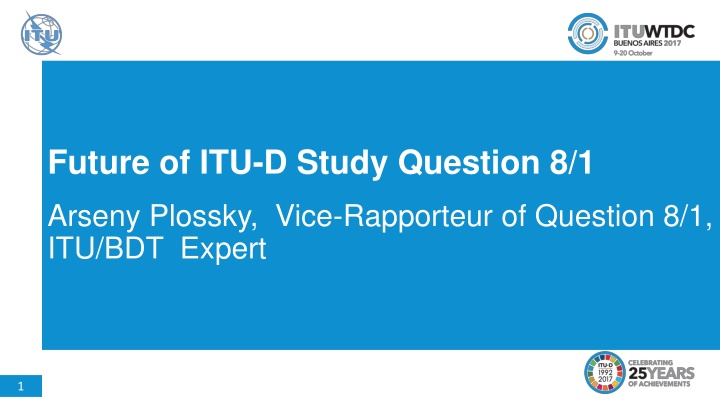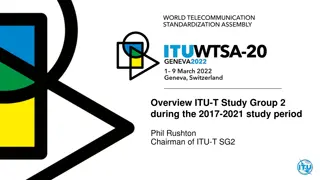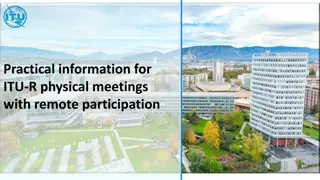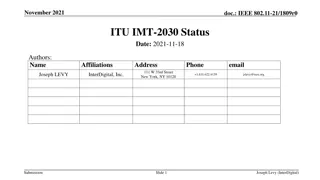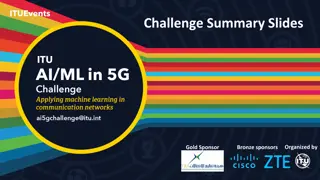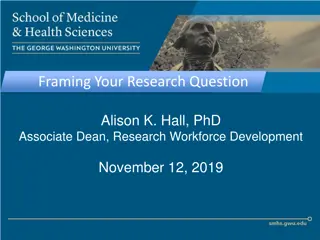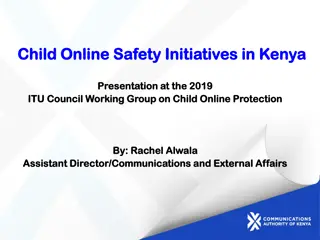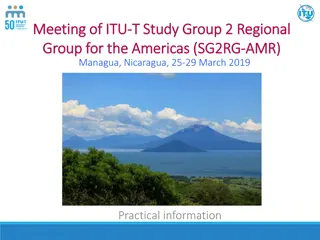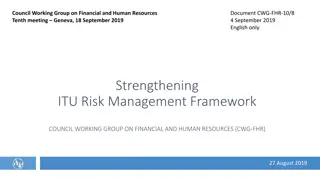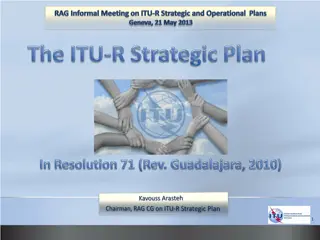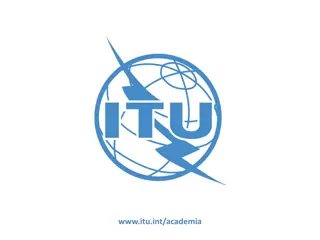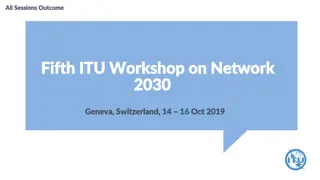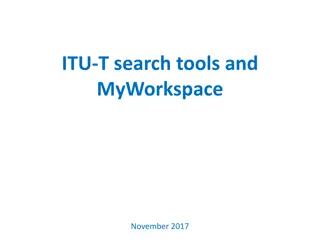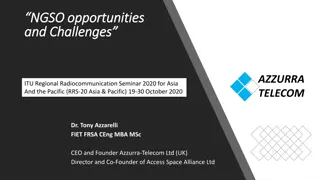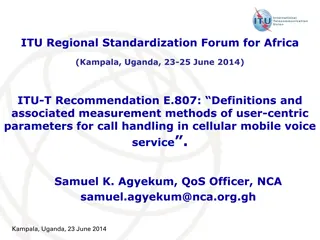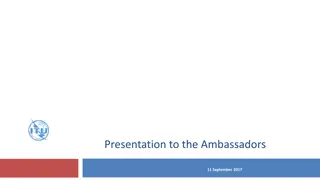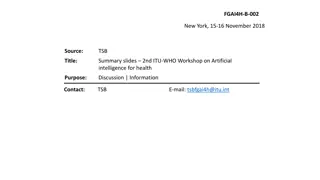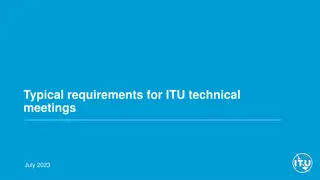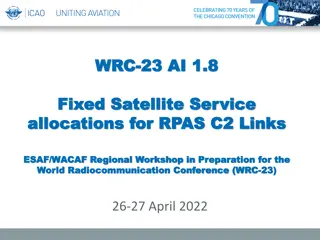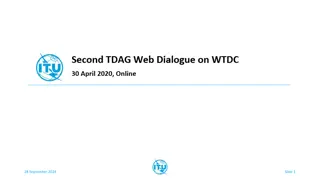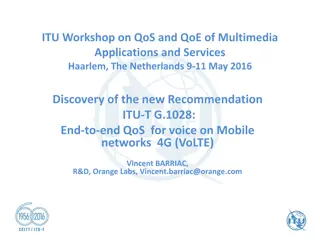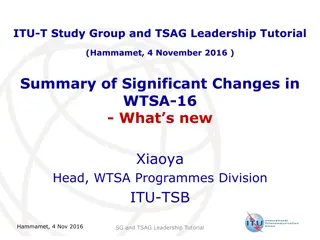Future of ITU-D Study Question 8/1 Report Analysis
This report delves into the impact of terrestrial television broadcasting coexisting with telecommunication services, focusing on the transition to digital terrestrial television. It covers strategies for analogue switch-off, spectrum planning, and digital dividend use. The report also includes case studies and best practices for transitioning from analogue to digital broadcasting in developing countries.
Download Presentation

Please find below an Image/Link to download the presentation.
The content on the website is provided AS IS for your information and personal use only. It may not be sold, licensed, or shared on other websites without obtaining consent from the author.If you encounter any issues during the download, it is possible that the publisher has removed the file from their server.
You are allowed to download the files provided on this website for personal or commercial use, subject to the condition that they are used lawfully. All files are the property of their respective owners.
The content on the website is provided AS IS for your information and personal use only. It may not be sold, licensed, or shared on other websites without obtaining consent from the author.
E N D
Presentation Transcript
Future of ITU-D Study Question 8/1 Arseny Plossky, Vice-Rapporteur of Question 8/1, ITU/BDT Expert 1
Current Topics Impact on developing countries of the coexistence of terrestrial television broadcasting with other terrestrial telecommunication services, taking into consideration relevant activities carried out in the other two ITU Sectors, including new uses for the digital dividend. Analysis of gradual transition to digital terrestrial television broadcasting, focusing mainly on the activities necessary for the analogue switch-off, including: a) analysis of ongoing progress in the quantity/availability of receiving terminals for reception by users of both sound and TV digital terrestrial broadcasts; b) analysis of various analogue switch-off strategies, including economic/financial benefits granted to lower-income people for the acquisition of the necessary means for terrestrial reception of digital broadcasting signals; c) analysis of spectrum re-planning strategies, such as the reallocation of existing broadcasting channels, to allow the coexistence of broadcasting and other services, considering new uses for the digital dividend; and d) analysis of effective marketing strategies to accelerate the process of public awareness about digital broadcasting. 2
Current Topics (continue) Spectrum planning for bands allocated to broadcasting services in preparation for the analogue switch-off, the digital dividend, and possible band plans, the planning of different services including allotment plans, and specific bands to be allocated to broadcasters after the analogue switch-off, within the purview of ITU-R. The use of the digital dividend frequency bands resulting from the transition to terrestrial digital broadcasting, including technical, regulatory and economic aspects, such as: a) status of the use of the digital dividend frequency bands; b) standards/recommendations adopted or currently being studied by the other two ITU Sectors related to the topic; c) sharing of the digital dividend frequency band; d) harmonization and cooperation at regional level; e) the role of the digital dividend in saving financing, cost savings on the transition to digital, and best experience and practice in this regard. 3
Report of Question 8/1 (2014-2017) CHAPTER 1 television broadcasting, especially those to speed up the transition and to conclude the Analogue Switch off CHAPTER 2 Marketing strategies to accelerate the process of public awareness about digital broadcasting CHAPTER 3 Planning the use of spectrum for the Analogue Switch off CHAPTER 4 The use of the digital dividend frequency bands CHAPTER 5 Countries Case Studies on the Transition to Digital Broadcasting and the use of the digital dividend frequency bands Best Practices for the transition from analogue to digital 4
Additional outcome of Question 8/1 Guidelines on Communications Strategies for the Transition from Analogue to Digital Terrestrial Broadcasting CHAPTER 1 process of public awareness about digital broadcasting CHAPTER 2 Information campaigns for the general public CHAPTER 3 Media communication campaigns CHAPTER 4 Communication strategies targeted to low income population Communication planning to accelerate the 5
Number of contributions received per Study Group 1 Question (September 2014 March 2017) 6
Analysis of feedback received through the global survey of Q. 9/2 on the work of ITU-D study groups (Question 8/1) Purpose In line with the ITU Telecommunication Development Sector s (ITU-D) ongoing commitment to innovation, the purpose of the survey is to seek the views of ITU-D Study Group 1 and 2 participants on the groups activities and outputs for the 2014 2017 study period, and on future activities for the next study period. Comments received from the survey will be shared with ITU Members, particularly to benefit and inform those who may seek to formulate proposals on these issues at Regional Preparatory Meetings (RPMs) and at WTDC-17. The survey results are also intended to complement the feedback obtained from Member States through the survey initiated by ITU-D Study Group 2 Question 9/2 on these issues. Audience: Participants in ITU-D Study Group and Rapporteur Group meetings Survey period: 1 28 February 2017. Structure Section 1: Contact information Section 2: Analysis and proposals on ITU-D Study Group 1 and 2 study Questions Section 3: Proposals to strengthen the activities of the ITU-D study groups during the next study period 28 responses received from entities in 22 countries and other organizations https://www.itu.int/dms_ties/itu-d/md/14/sg01/c/D14-SG01-C-0458!N1!PDF-E.pdf 7
Analysis of feedback received through the global survey of Q. 9/2 on the work of ITU-D study groups (Question 8/1) ADMIN AFR Equipment producers and users need to move in the same ship. The period that was set for migration to digital has passed so the Question needs to be reviewed to take that into account. There are some countries that have not been able to meet the deadlines. Their challenges need to be explored. ASP For the benefit of developing countries. CIS Need to add additional new topics like transition on digital sound broadcasting. EUR It is proposed to include the digital divide ADMIN RELATED AFR are still in the experimental phase with new digital radio services. The transition from analogue to digital will be effective when analogue service is extinguished. So Question 8/1 deserves to continue because most countries Reports and direct assistance have been provided. It is time to move forward. MINISTRY ASP Encourage members to shift from analog to digital broadcasting to catch technology advances. ROA ASP Useless. SIO EUR Avoid duplication with the work of Q1/1 and Q2/1. UNIVERS, RSRCH AMS For the next study period the driver should be sound broadcasting. 8
Feedback received through the survey on ITU-D Study Group Questions, Procedures, and Proposals on Future Activities (Question 8/1) 21 responses: Continue - 67% Revise - 14% Merge - 5% Suspend - 14% 9
Report of Question 11-3/2 (2010-2014) CHAPTER 1 Statement of the Situation, Introduction and Executive Summary CHAPTER 2 Identification of Milestones for Successful Transition from Analogue to Digital Broadcasting CHAPTER 3 Spectrum Planning Issues CHAPTER 4 Impact of Convergence with Other Terrestrial Telecommunication Services and Interactive Multimedia Applications Enabled by Terrestrial Digital Broadcasting CHAPTER 5 Key aspects of households' digital receiving terminal park CHAPTER 6 Local Production and/or Adequate Supply of Equipment, Receiving Park Inclusive CHAPTER 7 Best Practices (Production, Distribution, Multiplex and Broadcasting Networks), Public Policies and Case Studies 10
Management team discussion on the future of Question 8/1 Broaden the scope of the question not restricting it to Analogue to Digital Television Broadcasting: Evolution of the Digital Transition in Broadcasting [DVB-T to DVB-T2, SD to HD, MPEG2 to MPEG4]; Digital Radio (Sound) Broadcasting; Use of the released spectrum to new services and applications, including collection of case studies and best practice: Bridging the digital divide; Development of rural communications; Collection of best practices and countries experiences on interference mitigation between broadcasting and new services; Implementation of new services and applications: Community and Regional TV on DTV; New Broadcasting Services: 3D, 4K, 8K, etc; multimedia/interactive services; mobile television; Economic aspects of the deployment of new broadcasting services and applications: Deployment costs; Impact of other television distribution platforms (IPTV, Cable, Satellite, etc) on terrestrial broadcasting market. 11
Discussion during Study Group 1 on the future of Question 8/1 Regarding the future of Question 8/1, while it was noted in the participant survey that many transition deadlines for analogue to digital terrestrial television had passed, many countries are still in the experimental phase with new digital sound/radio services. New topics proposed during the Rapporteur Group meeting included broadening the scope of Q8/1 to include the evolution of the digital transition in broadcasting and digital radio/sound broadcasting, and how to use the released services and application; include economic aspects of the deployment of new broadcasting services and applications, as well as to study the impact of other television distribution platforms. Collecting countries experiences on interference migration between broadcasting and new service and the implementation of new services and applications (Community and regional TV on DTV and new Broadcasting services: 3D, 4K, 8K, etc.) were also deemed important. Including relevant issues related to people with disabilities was also supported. The Rapporteur Group proposed to continue the study Question. 12
Proposals from Member states contributions (Russian Federation) Changing the name of Question 8/1: Examination of strategies and methods of migration from analogue to digital terrestrial broadcasting and implementation of new services Proposals: Revise mandate of the Question. Entitle the Question Examination of strategies and methods of digital terrestrial broadcasting and implementation of new services . Assign the Question to new Working Party 1/1 Reduce inequality (Goal 10), including the digital divide . Purpose: The need to expand the scope of the Question, in particular, on the use of Digital Dividend and the transition to digital audio broadcasting. 13
Proposals from Member states contributions (China) Changing the name of Question 8/1: Examination of strategies and methods of migration from analogue to digital terrestrial broadcasting and implementation of new services Challenges and Opportunities for Video Services in ICT Applications Topics be studied: Estimate overall level of video services used to improve the social well-being, uplift the level of public services and enhance the productivity of different sectors and on the results achieved To summarize successful cases and experiences on using video services To study the prospects of new type of applications, which integrate video with ICT applications (such as e- government, distance education, and telemedicine), and their role in upgrading the level of video applications in developing countries. How to build the ICT networks able to meet the needs of the development of video services. Provide guideline for the construction of future ICT networks. To make policy makers, industry regulators, telecom operators, manufacturers understand the role of video services in improving people's living standards and manufacturing productivity and the role of ICTs in promoting the transformation and upgrading of enterprises. Cooperation in that field between abovementioned stakeholders as like as between developing and developed countries 14
Proposals from Member states contributions (C te d'Ivoire) It is proposed to continue the study Question. Reason: The migration from analogue to digital TV will be effective when analogue will be turn out. Therefore, that Question deserves to be continued because most countries are still on experimental step with new digital radio services. 15
Thank you very much for your kind attention! We are looking for your views and proposals!
